The Three Minute Thesis (3MT) celebrates the exciting research conducted by Doctor of Philosophy (PhD) and Professional Doctorate (Research) candidates. It is an international academic competition developed by the University of Queensland to cultivate students’ academic, presentation, and research communication skills.
3 Minute Thesis 2021
2021 UTS 3MT winners
3MT continued as online event due to COVID-19. While it was great to connect with people from all over the world and different time zones, it was not easy for our extraordinary finalists and judges. The judges had taken a considerate amount of time in choosing the winner and runner-up award for 2021 UTS 3MT, while 100% of our online audience were busy voting for their People's Choice.
And, the 2021 prizes were awarded to:
- Melissa Miao (Faculty of Health)
First prize: $3000 and represented UTS at 2021 Asia-Pacific 3MT competition - Monique Potts (Transdisciplinary Innovation School)
Runner-up: $1000 - Chelsea Vu (Faculty of Engineering and Information Technology)
People's Choice: $1000
Melissa won with her 3MT topic "Road to Recovery: A Map to Implement Online Communication Training After Brain Injury", by talking about healthcare interventions that are and are not used by patients and clinicians in real-world settings.
2021 UTS Three Minute Thesis (3MT) online competition
- Front row: MC Prof. Joanne Tipper, Comm specialist Samia Rahman, Judge Prof. Simon Knight, Judge Prof. Kate McGrath, Finalist Justin Hitchen.
- Second row: Finalist Sharni Collins from Science, Finalist Monique Potts from TIS, People's Choice winner Chelsey Vu from FIET, GRS organiser Chris O'Neill, Finalist Geoff Isaac from DAB.
- Third row: Finalist Gemma Sentance from Law, Finalist Jess MacArthur from ISF, Judge Nawshad Akther, GRS organiser Jing Zhao.
- Fourth row: Event coordinator Ness Heckscher, Event coordinator Melanie Steenkamp.
2021 Faculty Finalists
Overall Winner: Melissa Miao, Graduate School of Health
Runner-up: Monique Potts, Transdisciplinary Innovation School
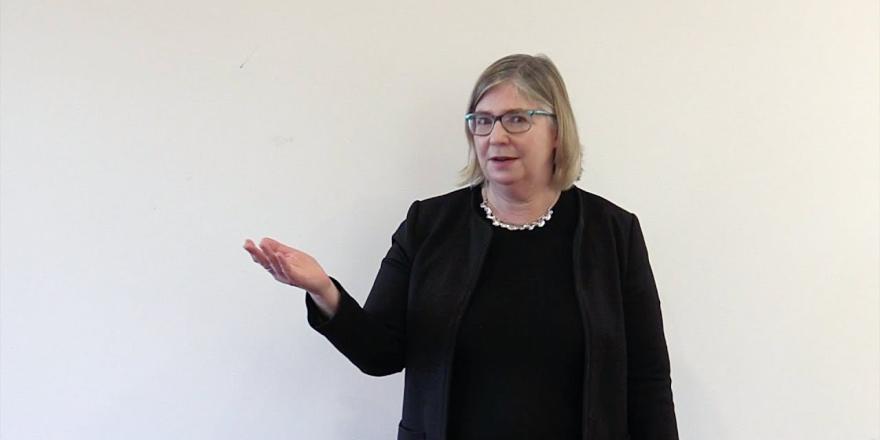
TRANSCRIPT:
Monique Potts — Resilience and experiential learning for young people
Have you ever imagined what it would be like to be a teenager in Australia in 2021? Do you think it’s harder to be a teenager now than it was in the past? How will their future be different to ours? What skills and competencies might help prepare them for an uncertain world? These are some of the questions I’ve been immersed in over the past few years in my PhD.
This story starts a little closer to home for me with my two daughters. Both my girls loved learning in primary school, however when they got to high school they started to lose interest in school and learning. At the same time I watched their mental health decline and did my best to support them through experiences of panic attacks, anxiety and depression.
Their schools seemed unprepared and under-resourced to deal with these challenges. It became clear to me as a parent, that the health and education systems were not really talking to each other. This left me feeling frustrated and at a loss to know what I could do to help.
So I started to research youth mental health in Australia to get a big picture of what was happening. What I found shocked me and I think might shock you too. Did you know that one in four young Australians are suffering from mental illness or psychological distress? Or that one in five students in are disengaged from learning and feel they don’t belong at school?
I went on to interview teachers, youth workers and students to get a sense of what they thought were the most important issues affecting resilience and wellbeing for young people. Some of the key themes to emerge included changing pathways for work and life, pressure around image and identity, a loss of connection and belonging and a looming sense of uncertainty.
To try to address this we’ve been working on co-designing a pilot program with year 10 students and teachers at a Sydney high school. Through this research we’ve identified a set of six meta-competencies to support greater resilience and wellbeing for young people, including agency, adaptability, creativity, compassion, interbeing and self-awareness.
With a team of experienced educators and practitioners we have designed six experiential learning modules that align with these meta-competencies. For example storytelling aligns with creativity and compassion, place-based learning with interbeing and self-awareness.
What is unique about this approach is that it focuses not only developing on personal resilience through social and emotional learning; but also collective resilience through learning to design interventions for complex real-world problems.
In the self-organising projects module students design a learning experience for younger students to improve their wellbeing, using the methods they have learned in the program and their own lived experience.
The preliminary research findings are very promising with an average engagement score of 8 out of 10 and feedback from students on real benefits to wellbeing and resilience. We hope to partner with the Department of Education to make this evidence-based framework and program available to other schools across NSW in 2022.
My heartfelt wish is that this research might help to reduce the trauma to young people and their families . And that our young people might not only survive but also thrive in our rapidly changing world.
Thanks for listening
People's Choice: Chelsey Vu, Faculty of Engineering and Information Technology
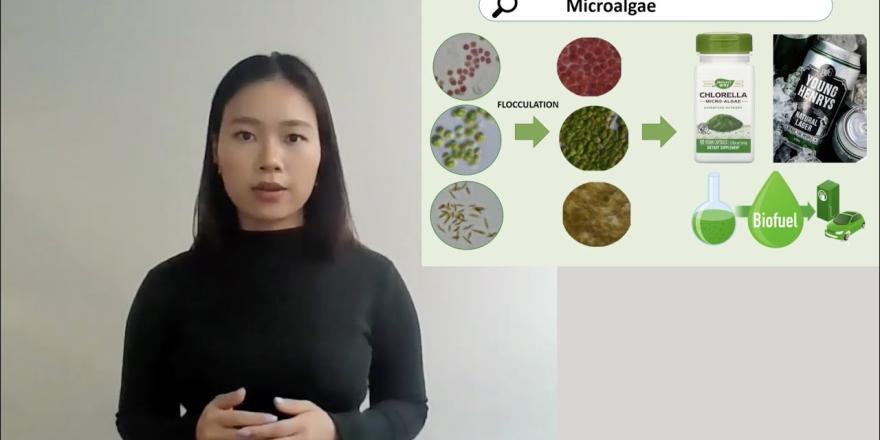
TRANSCRIPT:
Chelsey Vu — Microalgae: the foundation of tomorrow
Nowadays, if you go onto online shopping and type in the search “microalgae”, you will be able to find hundreds of microalgal based products that are advertised to be health and skin supplements.
But did you know what microalgae is and that microalgae can provide much more than just vitamin and collagen?
Microalgae is photosynthetic microorganism, invisible to naked eyes and are different from the large algae such as seaweed that we are familiar with. Microalgae is a renewable and climate-friendly resource that can transform many industries and evolve into a carbon-neutral bioeconomy.
The colour of our clothes and food can be obtained from microalgal pigments.
You can go into the supermarket and grab yourself a pack of algal beers.
Microalgae can also be used as feed for aquaculture, and a platform for carbon munching and wastewater treatment.
And the next thing you know is that you’re driving a motorbike or car fuelled by microalgae.
In reality, microalgal cultivation is easy but harvesting the microalgal cells from the diluted suspension to produce such valuable pigments and chemicals is still a difficult and expensive task.
To tackle this bottleneck, my PhD focuses on developing a low-cost and highly efficient microalgal harvesting technology using polymer flocculation. Polymers are positively charged and act like magnets to attract the negatively charged microalgae cells. Opposites attract!
When polymer is added to the algal solution, the cell surface charge is neutralised, making it sticky. The polymer then acts like a giant magnetic spider web to agglomerate thousands tiny algal cells together for collection.
Microalgae are tiny organisms and their cellular properties evolve as they grow. My research has shown that harvesting microalgae using polymer is the most effective at the beginning of the mature growth phase. This finding will help to optimise the cost and the quantity of microalgae harvested.
My research shows that flocculation for microalgal harvesting is competitive, requires 80% less energy and no complex equipment to achieve higher efficiency compared to traditionally used techniques such as centrifugation and membrane filtration. These advantages make polymer flocculation easier and more accessible to be implemented by microalgae farmers and producers, thus open ways to a new algal industry and create job opportunities for the industry.
I believe microalgae will be the foundation of our modern economy and we are getting closer to sustainable future where one day, an algae-fuelled airplane can take us to our next holiday destination.
Anne Casey, Faculty of Arts and Social Sciences

TRANSCRIPT:
Anne Casey — The second-wave impact in Australia of the Great Irish Famine: Eliza's story
Although you may not understand the words on my slide, in three minutes, I hope they will mean something to you…
Through my research, I’ve discovered a hidden cluster of refugee children who were abused and discriminated against because of their ethnic origins. My research seeks to restore voice to those who have been silenced.
Let me tell you a story… Everything I am going to tell you is true. It’s about a girl named Eliza.
Before she was born, a neighbouring nation invaded her country, killing almost half of Eliza’s people, the indigenous population who had lived there since prehistoric times. Their lands, language and culture were stolen.
Eliza’s people lived on the verge of starvation until their country was overwhelmed by a devastating famine. For five years, her people starved while their foreign rulers shipped vital food supplies out of Eliza’s homeland.
Over a million people died of hunger and disease. More than a million more fled the country as refugees. Eliza’s mother was one of more than 100,000 who died at sea.
Struggling against discrimination and destitution in her country of refuge, Eliza was arrested in a brothel at age 15. I’ve discovered that more than half the children in juvenile detention with her were from Eliza’s home country. They were sexually assaulted, humiliated and beaten. For attempting to escape, they were bound in straight jackets and locked in solitary confinement on starvation rations.
Eliza died aged 24, far from her native Ireland—my country, my people too. The events that led to her untimely death in Sydney were triggered by three factors: climate, politics and economics, together with a perhaps-mistaken belief that good people won’t fail to do something.
Blending in-depth archival research with my own family history, I am writing creative non-fiction and poetry to uncover new connections and reveal the human story behind the history.
Although Eliza died 145 years ago, there are one million ‘Elizas’ living in the shadow of her story in Australia today, 356 million children starving in our world due to the same three factors that sealed Eliza’s tragic fate.
My mission in telling you this story is to open one mind, one heart—yours. By raising our voices for the silenced, let us make sure that good people won’t fail to do something.
Those words on my slide are in Eliza’s and my native tongue, a language that was forbidden to our people. They translate as:
“People live in each other’s shadows”
In my culture that means we all depend on each other.
Sharni Collins, Faculty of Science
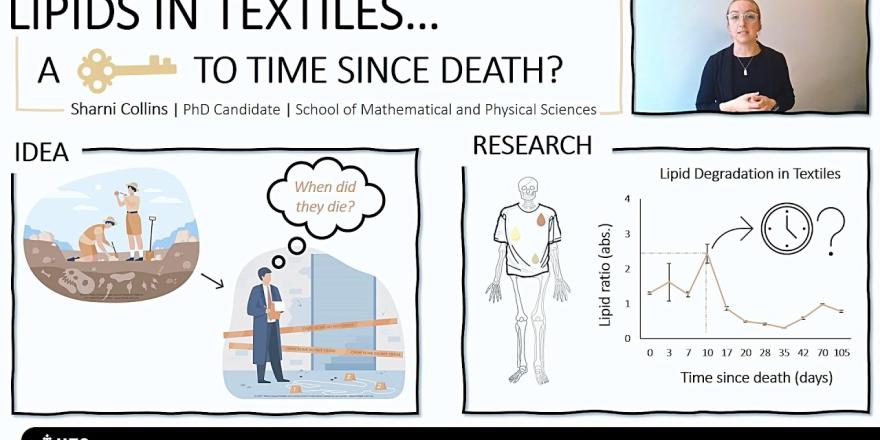
TRANSCRIPT:
Sharni Collins — Lipids in Textiles … A Key to Time Since Death?
What if I told you that our fashion choices could actually help forensic investigators estimate time since death?
What do I mean by that?
Well, textiles and clothing materials have actually been a target area for archaeological research for many years now, as a means to reconstruct the history of human civilizations across the globe. Now they do this by looking at the materials themselves, but also by looking at the residues trapped within them; so lipids for example when somebody dies and the body breaks down they get trapped within that material. And so lipids have proven to be incredibly useful because they can withstand really harsh environmental conditions and they have been found to be preserved in the environment for over a millennia.
We also know the way in which they break down over time. So let's bring that back to a forensic context, where a lot of our victims are wearing clothing and so when we do come across human remains it's very common that they are in association with clothing and that makes sense right because we're all wearing clothing on a daily basis. And so if we know that these lipids can be trapped in textiles and that they can be preserved for many years then why not use them as a means to map how long someone has been dead for and help assist police with that really important question, when did they die?
And so that's what I'm doing in my work. Now my work is conducted out of the Australian facility for taphonomy experimental research also known as AFTER. Which is a world-class facility that allows us to study whole human decomposition in a natural Australian environment. Now here I study how the body breaks down and this breakdown process occurs immediately after the heart stopped speeding and it continues up until all the soft tissue has been degraded. Now the timeline for this is really dependent on a range of intrinsic and extrinsic factors, like climate and insect activity, but we do know that regardless of that the macromolecules in the body, so the proteins the carbohydrates and the lipids, they start to break down and they're released into the immediate environment into the clothing that someone's wearing.
So that's what I take advantage of in my work. Now for my project I close both peak and human remains on the soil surface added after, and I take my samples from the front and the back of the body over a decomposition timeline. Now the reason that I'm studying both pig and human remains is because peaks have been used a lot in the past as models for human decomposition due to legal and ethical restrictions, but we don't actually know if they are a good model just yet. Now so far in my work what I have found is that lipids and textiles allow me to indirectly monitor decomposition. I've also found some patterns and trends in the arrival and disappearance of certain lipid products that are related to time since death. I'm also seeing a notable difference between the rate and manner in which pigs and humans decompose.
And so the end goal for my work is to continue this study of lipids in textiles so that I can map the timeline of death, and answer that all important question of when did they die?
Justin Hitchen, Faculty of Business
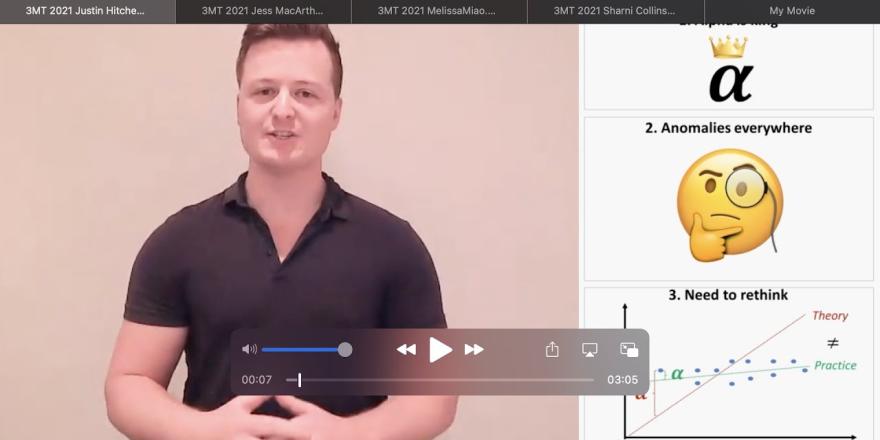
TRANSCRIPT:
Justin Hitchen — Rethinking Performance Evaluation
One of the major trends emerging during kobe was an increased participation in financial markets many people were seeking to build wealth via investment but what distinguishes a good investment from a bad investment you probably want an investment that will increase in value but you may also want to avoid anything with a lot of risk. I
In finance we rely on a metric called alpha to capture this balance, however my thesis questions where the alpha is reliable. In practice a positive alpha indicates a good investment and negative alpha indicates a bad investment. If there's a skilled investor in a financial market with a good investment strategy then investors like you and I will try to copy their approach. The alpha of their strategy will tend to zero in future years since it no longer outperforms investors like us.
So what's the problem with alpha anomalies? By the 90s academics recognized a couple of investment strategies that conflicted with our estimation model. People knew about and could copy these strategies, yet the alpha wasn't going to zero as a result. Our field assumed some of these strategies must somehow incur unknown risks, so we simply extended our initial model to include them as risk factors. That may have been a plausible solution in the 90s, but by now there are almost 500 published return anomalies that don't fit our estimation models. This has created a big puzzle in contemporary finance. Anomalies by definition should be scarce, yet they seem to be almost everywhere.
In my thesis I take a novel approach to find out why. I show that some of the most famous anomalies in finance are observable in random data. These anomalies are not the result of real world investment practice but rather they're an inevitable by-product of how we apply our alpha estimation models. The estimation approach taught to practitioners and employed in many academic papers forces our regression line through zero. If finance theory perfectly explained the real world then this would not be an issue, however as soon as the real world deviates from the theory—as it so often does—the estimation approach used in our field produces spurious alphas.
The consequence is that trillions of dollars’ worth of global investment decisions are currently being influenced by a faulty performance metric. Investors like you and i are adopting investment strategies that became popular due to misestimated alphas.
Based on my findings, I urge that we reconsider how we evaluate performance in finance. I recommend an alternate data-driven approach to alpha estimation. By adopting this alternative approach we can ensure that our field's dominant performance evaluation tool accurately evaluates performance. The outcome is improved global resource allocation and enhanced economic prosperity for all of us
Geoff Isaac, Faculty of Design, Architecture and Building
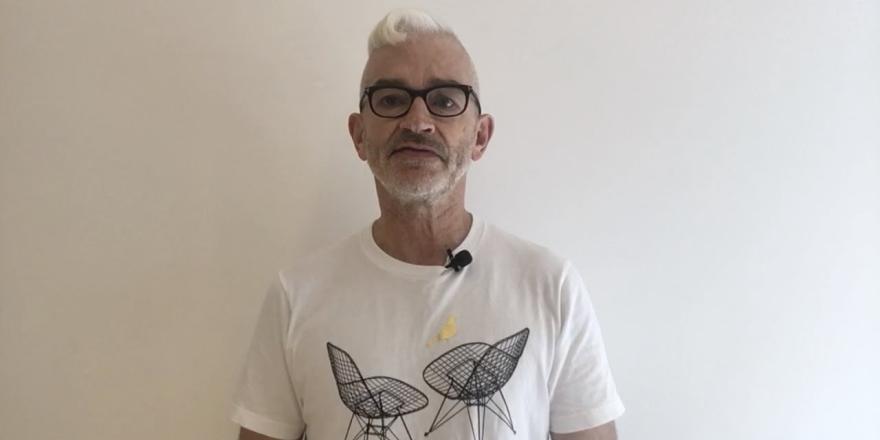
TRANSCRIPT:
Geoff Isaac — Could this chair help save the planet?
Could this plastic chair help save the planet?
Plastics cause enormous environmental damage—fossil fuels are burned to create them, and most end up in landfill, or littered polluting our oceans and even our food.
It gets worse—production of plastic will triple by 2050, by which time there will be more plastic in the ocean than fish.
We could try and stop using plastic altogether; good luck with that. But even if it were possible the environmental impact of using materials like wood or metal would just be worse.
There is a solution, renewable carbon plastics, that's recycled plastic and bioplastics. These materials were primarily developed for grocery suppliers keen to eliminate virgin fossil plastics from their packaging. That's great, but what about the thousands of plastic products that we use every day; pens, toothbrushes, smartphones, and even plastic chairs.
Made from recycled plastic the Bell Chair by Konstantin Grcic is about half a kilo lighter than other plastic chairs. It stacks vertically 12 high for transportation and can also be recycled. It's a perfect example of how design has the power to decrease the demand for planet destroying virgin fossil plastics. The Bell Chair is just one of many recent designs made from renewable carbon plastics, but are all these chairs more sustainable than a traditional plastic chair.
Tools do exist to make these types of comparisons, but they're very complicated to use, and industry just simply ignores them. I've created a simplified digital tool to calculate environmentally responsible product ratings for 32 chairs made from renewable carbon plastics, five perform much better than the rest.
Next I interviewed 20 leading international product designers including Philippe Starck and Karim Rashid, to get their expert opinions on renewable carbon plastics and the barriers to using them. I've analysed these interviews and studied the most environmentally friendly chairs such as the Bell Chair to identify what can be learned to drive the uptake of renewable carbon plastics. My 20 years’ experience marketing transitional technologies such as the internet and five years working on waste projects at the EPA have helped me here.
I am now applying a theoretical model to identify strategies to help designers and manufacturers transition to developing more environmentally friendly plastic products. While my focus has been on plastic chairs most findings are relevant to all those working with plastics.
We have no choice but to minimize our use of virgin fossil plastics going forward. My research helps accelerate the transition towards more eco-friendly plastics so we can all continue to enjoy the countless benefits of plastic while we leave the ocean for the fish.
Jessica MacArthur, Institute for Sustainable Futures
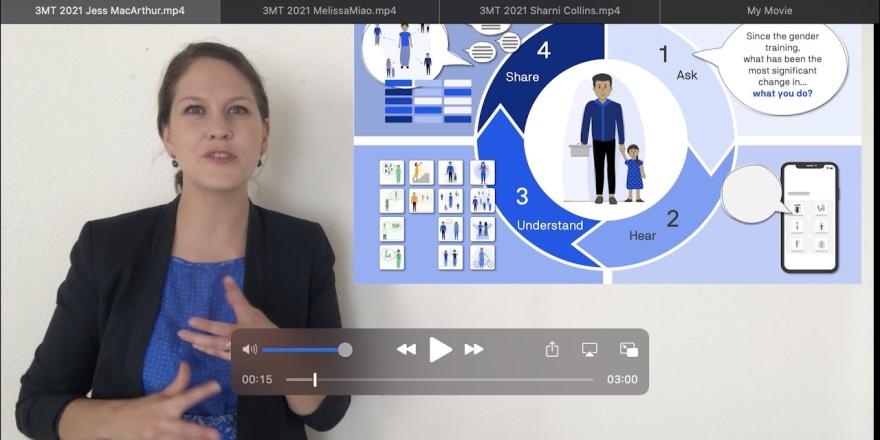
TRANSCRIPT:
Jess MacArthur — Four methodological innovations: Evaluating changes in gender equality at work
Hi there, I'd like to introduce you to Samai. Now, Samai is a regional manager in an aid program in rural Cambodia, and about a year ago he took part in the gender training put on by his organization. After the training he began taking a more active role in household work, something he'd always seen as “women's work”. And the ripple effects of a gender training at the office into the gender dynamics into Samai‘s household have been significant.
Understanding this change is important to gender equality work in Cambodia and beyond. Now, my work is a little bit different, my research has been research on research—we call this methodological research, and I've been investigating innovative ways to ask about hear understand and share stories like Samai’s. Although Samai's story might seem straightforward asking questions about gender equality is notoriously difficult, especially in cross-cultural contexts.
So the first part of my research has been understanding how best to ask good questions about changing gender dynamics, and I learned the questions which rely on basic verbs work the best. Questions like, what's changed about what you do, or about how you speak.
Second, I had to find a good way to hear answers from these questions from staff members spread across rural Cambodia all during a lockdown. So I co-designed a data collection method where staff use their own smartphones to share stories through photos, audio recordings, or short text messages, and I learned that offering both text and audio options created safer opportunities for staff to share personal stories; and I heard over 200 stories of change.
Then I had to actually understand the stories, so I designed and piloted a cutting-edge persona-based approach to story analysis. Using both verb-based thematic coding and natural language processing algorithms identified 14 unique personas of change representing all the common types of change from the program staff, and out of the 176 staff that participated in this research there were actually 19 men with similar stories to Samai. Samai is actually a persona.
Finally, I had to find and use effective ways to share stories to strengthen future gender training, so I explored and tested communication methods that work in cross-cultural contexts, while maintaining integrity of findings. And I learned from program teams that data-driven infographics and cartoons with actual quotes are ways that help them most engage with and use findings.
Each of these four innovations expands the sector's thinking on monitoring changes in organizations, by centring on participants voices and leaning in to creativity. Stories really matter. And an important way of understanding the complexities of gender equality.
With these new ways of investigating impacts I hope that organizations will be better equipped to ask, hear, understand, share and ultimately learn from stories like Samai’s.
Gemma Sentance, Faculty of Law
This video has been removed by request of the student.
